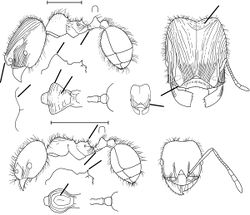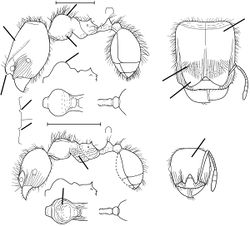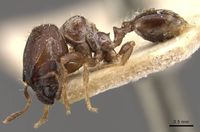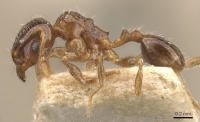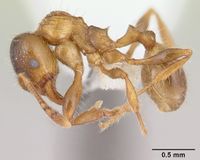Key to Pheidole aberrans group
This worker key is based on: Wilson, E. O. 2003. Pheidole in the New World: A dominant, hyperdiverse ant genus. Harvard University Press, Cambridge, MA.
This compact and distinctive assemblage is probably monophyletic as constituted here. Most likely a sister group of the tristis group, it appears almost wholly limited to subtropical and warm temperate South America. One species, Pheidole fracticeps, is known from Trinidad and Ecuador. Another species, Pheidole pullula of Argentina, is transitional to the tristis group and placed there; it differs from all the aberrans-group species below in having a completely smooth occiput.
You may also be interested in
1
- Major: short carinulae are present, but prominent transverse carinae do not extend all the way across the occiput in full-face view; in side view, a sharp toothlike projection points forward from the anterior third of the ventral profile of the petiole (Argentina) . . . . . Pheidole subaberrans
- Major: one to several prominent transverse carinae extend all the way across the occiput in full-face view; in side view the anterior ventral profile of the petiole is either level or at most forms a low, rounded convexity . . . . . 2
2
return to couplet #1
- Major: posterior half of the dorsal head surface smooth and shiny . . . . . 3
- Major: posterior half of dorsal head surface covered by longitudinal carinae . . . . . 4
3
return to couplet #2
- Mesopleuron of minor worker smooth and shiny; Head Length of major 1.4X its Head Width (Argentina, Uruguay, southern Brazil) . . . . . Pheidole cavifrons
 Pheidole cavifrons, Major |
- Mesopleuron of minor worker covered by longitudinal carinulae; Head Length of major only 1.2X its Head Width (Argentina) . . . . . Pheidole weiseri
4
return to couplet #2
- Major: frontal lobes in full-face view are hornlike, their tips forming sharp acute angles that project well beyond the anterior clypeal border (Argentina) . . . . . Pheidole taurus
 Pheidole taurusm Major |
- Major: frontal lobes seen full face rounded or square, at most just reaching the anterior clypeal border . . . . . 5
5
return to couplet #4
- Frontal lobes of major seen full face just reaching anterior clypeal border . . . . . 6
- Frontal lobes of major seen full face ending behind anterior clypeal border . . . . . 7
6
return to couplet #5
- Major: posterior half of side of head covered with parallel longitudinal carinulae; posterior fourth of dorsum of head covered by curved transverse carinulae; frontal lobes rounded anteriorly (Minas Gerais, Brazil) . . . . . Pheidole minensis
- Major: posterior half of side of head bare; posterior one-fourth of dorsum of head bare except for dominant transverse carina; frontal lobes square in front (Argentina) . . . . . Pheidole laticrista
 Pheidole laticrista, Minor |
7
return to couplet #5
- Major: frontal lobes seen in full face just reaching the posterior clypeal border latenid to the tips of the frontal lobes . . . . . 8
- Major: frontal lobes seen in full face extending beyond the posterior clypeal border laterad to the tips of the frontal lobes . . . . . 9
8
return to couplet #7
- Minor: pronotal dorsum bearing irregular carinulae; entire region between eye and antennal fossa covered with carinulae, foveolae, and rugoreticulum (Argentina) . . . . . Pheidole lilloi
- Minor: pronotal dorsum lacking carinulae; region between eye and antennal socket foveolate only (Ecuador and Trinidad) . . . . . Pheidole fracticeps
 Pheidole fracticeps, Major |
9
return to couplet #7
- Major: head bicolored, with portion anterior to eyes dark brown and rest of head yellow; head strikingly elongate (Head Length 1.6X the Head Width) (Misiones, Argentina) . . . . . Pheidole longior
- Major: head concolorous light to reddish brown or yellow (Head Length only 1.1-1.2X Head Width) . . . . . 10
10
return to couplet #9
- Major: pronotum longitudinally cannulate; Head Width 1.2 mm; body concolorous light brown (Argentina) . . . . . Pheidole obnixa
 Pheidole obnixa, Major |
- Major: pronotum bare; Head Width 1.4--1.7 mm; body reddish yellow or light reddish brown . . . . . 11
11
return to couplet #10
- Major: in full-face view occipital carinulae dip anteriorly to a point to create a triangular field; in full face, external borders of frontal lobes concave; Head Width 1.7 mm (Argentina) . . . . . Pheidole obscurifrons
 Pheidole obscurifrons, Major |
- Major: in full-face view, carinulae not dipping anteriorly to a point to form a triangular field; in full face, external borders of frontal lobes straight; Head Width 1.4 mm (Argentina to central Brazil) . . . . . Pheidole aberrans
 Pheidole aberrans, Major |

|
